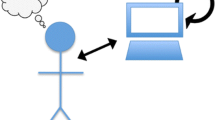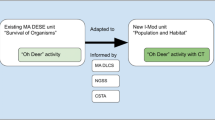Abstract
In this paper, we explore dynamic modeling as an opportunity for students to think about the science content they are learning. We examined the “Cognitive Strategies for Modeling” (CSMs) in which students engaged as they created dynamic models. We audio- and videotape-recorded eight pairs of ninth grade science students and analyzed their conversations and actions. In analyzing appropriate objects and factors for their model, some students merely enumerated potential factors whereas others engaged in rich, substantial, mindful analysis. In reasoning about their models, students discussed relationships in depth, concentrated only on the most important key relationships, or encountered difficulty distinguishing between causal and correlational relationships. In synthesizing working models, students mapped their model to aid visualization, focused on their goal, or talked about their model's appearance or form. Students attempted to articulate explanations for their relationships, but sometimes their explanations were shallow. In testing their models, some students tested thoroughly but only a few persisted in debugging their model's behavior so that it matched their expectations. In our conclusion we suggest that creating dynamic models has great potential for use in classrooms to engage students in thought about science content, particularly in those thinking strategies best fostered by dynamic modeling: analysis, relational reasoning, synthesis, testing and debugging, and making explanations.
Similar content being viewed by others
REFERENCES
Bruner, J. S. (1973). Beyond the Information Given. W.W. Norton, New York.
Forrester, J. W. (1968). Principles of Systems. Wright-Allen Press, Cambridge, MA.
Gardner, H. (1991). The Unschooled Mind: How Children Think and How Schools Should Teach. Basic Books, New York.
Gilbert, S. W. (1991). Model building and a definition of science. Journal of Research in Science Teaching, 28, 73–79.
High Performance Systems (1992). Stella II: An Introduction to Systems Thinking.
Huebel-Drake, M., Finkel, E., Stern, E., and Mouradian, M. (1995). Planning a course for success. The Science Teacher, 62, 18–21.
Jackson, S., Stratford, S. J., Krajcik, J., and Soloway, E. (1996). Making dynamic modeling accessible to pre-college science students. Interactive Learning Environments, 4, 233–257.
Mandinach, E. B., and Cline, H. F. (1994). Classroom Dynamics: Implementing a Technology-Based Learning Environment. Erlbaum, Hillsdale, NJ.
Miller, R., Ogborn, J., Briggs, J., Brough, D., Bliss, J., Boohan, R., Brosnan, T., Mellar, H., and Sakonidis, B. (1993). Educational tools for computational modelling. Computars in Education 21, 205–261.
Perkins, D. (1992). Smart Schools: From Training Memories to Educating Minds. The Free Press, New York.
Roberts, N., and Barclay, T. (1988). Teaching model building to high school students: Theory and reality. Journal of Computers in Mathematics and Science Teaching, 8, 13–24.
Roberts, N., Andersen, D. F., Deal, R. M., Garet, M. S., and Shaffer, W. A. (1983). Introduction to Computer Simulation: A System Dynamics Modeling Approach. Productivity Press, Portland, OR.
Schecker, H. (1993). Learning physics by making models. Physics Education, 28, 102–106.
Silvert, W. (1993). Object-oriented ecosystem modeling. Ecological Modeling, 68, 91–118.
Soloway, E., and Pryor, A. (1996). The next generation in human-computer interaction. Communications of the ACM, 39, 16–18.
Stratford, S. J. (1996a). Opportunities for thinking: constructing models in precollege science classrooms. Paper presented at the Annual Meeting of the American Educational Research Association. New York, New York, April, 1996.
Stratford, S. J. (1996b). Investigating processes and products of secondary science students using dynamic modeling software. Unpublished doctoral dissertation, University of Michigan, Ann Arbor.
Stratford, S. J. (1997). A review of computer-based model research in precollege science classrooms. The Journal of Computers in Mathematics and Science Teaching, 16, 3–23.
Stratford, S. J., Krajcik, J., and Soloway, E. (1997). Teachnological Artifacts Created by Secondary Science Students: Examining Structure, Content, and Behavior of Dynamic Models. Paper presented at the annual meeting of the National Association of Research in Science Teaching, Chicago, IL, March, 1997.
Stratford, S. J., Krajcik, J., and Soloway, E. (1996). Cognitive strategies in dynamic modeling: case studies of opportunities taken and missed. In D. Edelson and E. Domeshek (Eds.), Proceedings of the International Conference on the Learning Sciences, Evanston, IL, July, 1996.
Author information
Authors and Affiliations
Rights and permissions
About this article
Cite this article
Stratford, S.J., Krajcik, J. & Soloway, E. Secondary Students' Dynamic Modeling Processes: Analyzing, Reasoning About, Synthesizing, and Testing Models of Stream Ecosystems. Journal of Science Education and Technology 7, 215–234 (1998). https://doi.org/10.1023/A:1021840407112
Issue Date:
DOI: https://doi.org/10.1023/A:1021840407112




